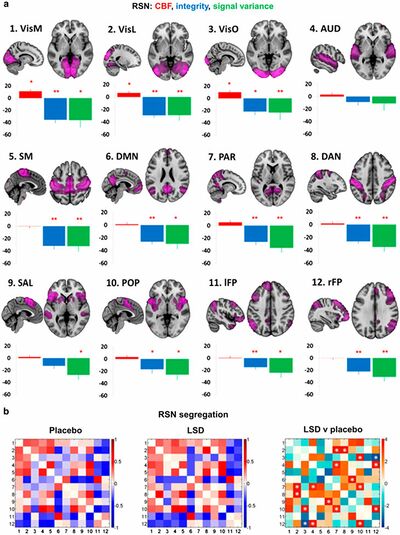Talk:Auditory distortion
Neurological Analysis
LSD changes how your brain connects to the thalamus
"In addition, LSD-induced RSFC [Resting State Functional Connectivity] between the thalamus and right fusiform gyrus and insula correlated with subjective visual and auditory alterations, respectively (Mueller et al, 2017b). Remaining to be determined is the way in which LSD-induced increases in thalamocortical connectivity may be linked to the thalamic gating of perceptions (Mueller et al, 2017b). In contrast to the higher connectivity between neural networks while under the effects of LSD, LSD globally decreased within-network RSFC (integrity) and within-network signal variance (Carhart-Harris et al, 2016c) (Figure 2a).
(a) Mean percentage differences (+SEM) in CBF (red), integrity (blue), and signal variance (green) in 12 different resting-state networks (RSNs) under LSD relative to placebo (red asterisks indicate statistical significance, *P<0.05; **P<0.01, Bonferroni corrected). (b) Differences in between-RSN RSFC or RSN ‘segregation’ under LSD vs placebo. Each square in the matrix represents the strength of functional connectivity (positive=red, negative=blue) between a pair of different RSNs (parameter estimate values). The matrix on the far right displays the between-condition differences in covariance (t values): red=reduced segregation and blue=increased segregation under LSD. White asterisks represent significant differences (P<0.05, FDR corrected; n=15). Reproduced from Carhart-Harris et al (2016c)."[1]
Hallucinogen distortions are from disrupted synchrony of your neurons
pg 634 "Hallucinogens disrupt PFC network activity, and after administration of hallucinogens, individual pyramidal neurons are less likely to fire in synchrony with other pyramidal neurons, and low-frequency network activity is attenuated. Since the efficiency of cortical information processing is dependent on cortical synchrony, these effects could markedly alter how the PFC functions. Furthermore, the increase in recurrent cortical network activity induced by hallucinogens could compete with responses induced by sensory input, potentially altering sensory processing. Since pyramidal neurons in PFC layer V are the source of projections to other cortical and subcortical structures, hallucinogen effects on PFC activity and processing could profoundly affect how the PFC regulates activity in those projection sites. For example, systemic administration of DOI to rats increases the output of mPFC neurons projecting to DRN and the VTA in the midbrain, which give rise to serotonergic and dopaminergic projections, respectively. It has been proposed that one of the major effects of hallucinogens may be to alter the function of cortico-striato-thalamic pathways (CSTC loops) that regulate the gating of cortical information processing. Altered activity in these circuits, due to the direct and indirect effects of hallucinogens on their cortical and subcortical components, could produce gating deficits that would result in sensory overload, hallucinations, and disruptions of normal cognitive processes. Indeed, one of the known effects of hallucinogens in humans and rodents is disruption of measures of sensorimotor gating such as prepulse inhibition. The hypothesis that hallucinogens act by disrupting CSTC feedback loops has received some support from imaging studies showing that psilocybin alters activity in cortical and subcortical components of the “limbic” CSTC loop."[2]
There are disruptions to auditory adaptation through modulation of the 5HT2A receptor
"The 5HT2A receptor modulates auditory prepulse inhibition which attenuates a startled response. Prepulse inhibition is an previous pulse allowing for adaptation to a stimulus. [Deficits of prepulse inhibition manifest in the inability to filter out the unnecessary information; they have been linked to abnormalities of sensorimotor gating.] In summary, these data indicate that, at least under the conditions of the present studies, the disruptions of auditory prepulse inhibition produced by fenfluramine, MDMA, and DOI result from stimulation of 5-HT2A receptors. Furthermore, these disruptions do not involve direct or indirect stimulation of D2 receptors. The identity of the 5-HT receptor(s) underlying the disruptive effects of fenfluramine or MDMA on visual prepulse inhibition has not yet been identified."[3]
References
- ↑ Liechti, M. E. (2017). Modern clinical research on LSD. Neuropsychopharmacology, 42(11), 2114. https://doi.org/10.1038/npp.2017.86
- ↑ Halberstadt, A. L., & Geyer, M. A. (2013). Neuropharmacology of lysergic acid diethylamide (LSD) and other hallucinogens. In Biological research on addiction (pp. 625-635). https://doi.org/10.1016/B978-0-12-398335-0.00061-3
- ↑ Padich, R. A., McCloskey, T. C., & Kehne, J. H. (1996). 5-HT modulation of auditory and visual sensorimotor gating: II. Effects of the 5-HT 2A antagonist MDL 100,907 on disruption of sound and light prepulse inhibition produced by 5-HT agonists in Wistar rats. Psychopharmacology, 124(1-2), 107-116. https://doi.org/10.1007/BF02245610
